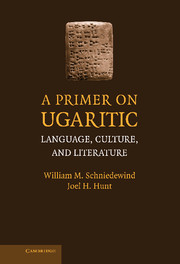9 - Resources for Further Study
Published online by Cambridge University Press: 05 June 2012
Summary
SUGGESTIONS FOR FURTHER STUDY
This primer is intended only to guide a student through the first semester of a course in Ugaritic. We realize that many students will not go much further. Here we offer a selected annotated bibliography for those students who desire further study. This bibliography is not complete, but it should give the student more than enough resources to begin further study. Some students will also know (or should soon be studying) European languages that are necessary for scholarly research into Ugaritic. We have given some annotation to the more significant works.
For further studies, students will want to have Daniel Sivan's A Grammar of the Ugaritic Language, which is now the standard reference grammar in English. Research into Ugaritic grammar should begin with J. Tropper's monumental, Ugaritische Grammatik (2000), along with D. Pardee's equally monumental review in Archiv für Orientforschung 50 (2003/2004). The standard dictionary is G. del Olmo Lete and J. Sanmartín's A Dictionary of the Ugaritic Language in the Alphabetic Tradition. Excellent digital images of the Ugaritic tablets can be found at the Inscriptifact web site, http://www.inscriptifact.com/, an image database of inscriptions and artifacts compiled by Bruce Zuckerman, Marilyn Lundberg, and Leta Hunt of West Semitic Research. The student will find that Watson and Wyatt's Handbook for Ugaritic Studies[=HUS]—though too expensive for many impoverished students to buy—will be a good starting place for most areas of research into the Ugaritic language, literature, history and culture.
- Type
- Chapter
- Information
- A Primer on UgariticLanguage, Culture and Literature, pp. 210 - 221Publisher: Cambridge University PressPrint publication year: 2007



